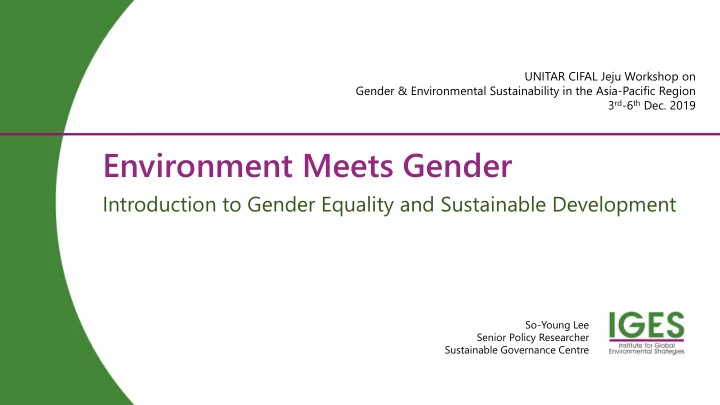

UNITAR CIFAL Jeju Workshop on Gender & Environmental Sustainability in the Asia-Pacific Region 3 rd -6 th Dec. 2019 Environment Meets Gender Introduction to Gender Equality and Sustainable Development So-Young Lee Senior Policy Researcher Sustainable Governance Centre
OUTLINE INTRO CONCERNS • Environmental Justice Gender equality • Ecofeminism Ecological Ideas CASES • Climate Impact & Response Gaps on Gender Empowering Women to Mitigate Climate Change DISCUSSION 2
“Poverty is hierarchical; while, smog is democratic.” By U. Beck [Risk Society] Based on empirical studies, HUMAN DEVELOPMENT many environmental harms are distributed REPORT 1992 just as unevenly as most commodities. (Source: UNDP 1992) 3 3
Environmental Injustice Intra-generational Income e.g. Race has high correlation with toxic waste facilities because 1) Minority live in cheapest area Race/Colour 2) Less resistance for job creation North vs. South 3) Unable to move out (even move in) 4) Low economic/political status Gender Inter-generational Sustainable Development is “Development that meets the needs of the present without compromising the ability of future generations to meet their own needs.” The Brundtland Report 1987 [Our Common Future] Inter-species 4 4
Ecological Concerns Deep Ecology aim for the radical transformation of the existing anthropocentric and dichotomous worldview to ecological ones i.e. interconnected humans and nature. Influenced by the Eastern philosophy i.e. coexistence and mutual prosperity of all the living beings sustains the whole of nature. place the struggle in a political and a historical context and seek to fundamentally transform Social Ecology current society which dominated by bureaucratic rationality and capitalism those subdued both workers and nature. appeared first in D’Eaubonne’s Le Féminisme Ou La Mort that encourage women to lead an Eco-feminism ecological revolution to save the plant from environmental and inequality problems. envisage a new society: ecologically sustainable with no gender division of labour; commitment to a non-gendered egalitarianism rather than ‘power-to-women’; revaluation of the spiritual and intuitive as alternative forms of knowledge to science and rationalism. argue women in Third World are often at the forefront of change to protect their own lives, those of their children, and the lift of the plant vs. First World combat by altering consumption habits, recycling wastes, and protesting production and disposal methods (Shiva, 1988; Merchant 1992) 5 5
Green Label Ethical Consumption Responsible Living parts
“Women are often primarily responsible for the everyday choices made in households, for the majority of agricultural work, and for ensuring families’ food security. This means that they play a key role in both production and consumption, and can make valuable contributions to low carbon development. Gender equality must be incorporated into all matters connected to climate change.” - Tarja Halonen, former President of Finland. (Source: Nordic Council of Ministries 2016) 7 7
Impacts of Climate Change Emission Scenarios and Projected Changes in Temperature Ref. The last ice age was 5°C lower than now Kyoto Protocol 1997 Paris Agreement 2015 (Source: Climate Action Tracker 2014) 8 8
Current Trend on Climate Response Improve public health SDGs (Source: www.undp.org) As countries implement 2015 Paris Agreement and 2030 Agenda for SD, NDCs and SDGs become the priority of its national development planning. Nationally Determined Contributions Emphasis on sustainability and inclusivity is growing: need to ensure climate change mitigation actions are consistent with other environmental priorities and socioeconomic needs. 9 9
Visualising Co-benefits Expand view of Co-benefits Climate Benefit SOCIAL CO-BENEFITS (e.g.CO 2 ↓) Improved HOB co-benefits ● Coal Storage ● Air Preheater ● Air Feed Adjustment ● Coal Feeder Selection ● Cyclone Dust Collector PM (kg/y ) Gender? Environmental Benefit 10 10 (e.g.PM ↓) (Source: www.ccacoalition.org/en/science-resources)
Gaps in knowledge on gender & climate issue Clean Out of 3,864 CDM projects, Development 5 mentioned empowerment of women Mechanism (Source: CDM Executive Board) Nationally Georgia’s Gender-Responsive NAMA is the only case Appropriate developed to involve women and men equally throughout Mitigation the design and implementation phases. Action (Source: NAMA Database Pipeline) Nationally Determined Contribution (Source: IUCN and USAID 2016) Gender experts often know little about climate change; climate experts often know little about gender. • The same climate-gender gaps that affect experts are often even greater for policymakers. • These gaps are likely greater for mitigation as opposed to adaptation. • 11 11
Harnessing CASE Climate Change Mitigation Initiatives to Benefit Women ADB TA7914-REG Create a gender-sensitivity by promoting a policy dialogue partnership • developing the capacity of key stakeholders • proactively affecting country-level pipeline initiatives • preparing gender-mainstreamed climate finance proposal i.e. • GCF project to ensure that the multi-stakeholder partnerships increase the flows of benefits for women from climate mitigation Through national level Stakeholder consultation, interviews, • training identify mutually beneficial ways for the collaboration of the Ministries and women’s groups 12
The pilot projects involved women in concrete on-the-ground initiatives that built knowledge and skills to mitigate climate change while earning other livelihood benefits. Simultaneously, the institutional capacity building and policy mainstreaming empowered women and women’s groups, engaging them in decisions that could help achieve longer-lasting results. Multi-stakeholders at Multi-levels Institutional for Multi-benefits Capacity Development Policy Dialogue Pilot Initiatives 13 13
DISCUSSION 14 14
Recommend
More recommend